Contrary to what you may think, the Mercedes-Benz Bodybuilding division isn’t a collection of tanned musclemen who just happen to drive C-Classes.
Rather, it’s the German brand’s name for conversions – where third-party industries convert Mercedes vans to fit their own individual needs, whether that be ultimate carrying capacity in the form of a Luton, versatile minivan interiors or refrigerated vans for food delivery.
How does Mercedes do van conversions?
Mirroring Volkswagen’s Recognised Conversions scheme, Mercedes works with selected converters and is able to offer a greater level of support than might otherwise be the case.
Companies can become certified as a Van Partner, which means Mercedes has checked and can vouch for the quality of the individual third-party conversions.
What is a Mercedes Van Solution Partner?
For a greater level of peace of mind, there’s another level – Van Solution Partner.
Odd name aside, these conversions aren’t just recommended by Mercedes – they’re guaranteed under the same warranty as a standard van, maintainable through the same dealers and sold on a single invoice.
For all intents and purposes, buying a Van Solution Partner conversion is just like buying an OEM vehicle from Mercedes itself.
Which is the most popular Mercedes van for conversions?
Most of these conversions are based on the full-sized Sprinter van – which is cranked out by a plant in Ludwigsfelde, Germany at the rate of 75 per day. Some industries also convert the smaller Vito and Citan panel vans.
All shapes and sizes of Sprinter pass through the Ludwigsfelde plant but by far the most interesting for converters is the newest – the so-called ‘Tractor head’.
What is the Mercedes Sprinter Tractor head?
The Tractor head was introduced in 2018 and cleverly positions the entire drivetrain of the Sprinter – engine, transmission, fuel and exhaust systems – ahead of the B-pillar, making for a self-contained (and front-wheel drive) cab unit.
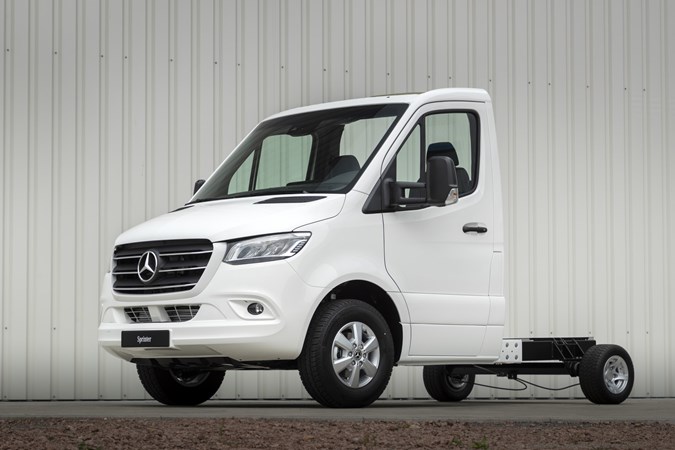
This gives bodybuilders a degree of flexibility they’ve not enjoyed before, as they’re now able to fit their own chassis to the rear and their own bodywork and interiors to the front.
It’s certainly a boon for campervan manufacturers – even more so when paired with the latest connected features, which can seamlessly meld camper functions with cab functions to allow the control of heating or water systems through the van’s own infotainment, or a companion app.
It could this make the Sprinter the first van to challenge the dominance of the Fiat Ducato in the European motorhome market.
Are there different categories of Mercedes bodybuilder van conversion?
Mercedes splits its bodybuilding division loosely into several categories:
- Campervans
- People-movers
- Courier, express and parcel delivery
- Emergency services
- Restricted mobility
- Service, crafts and construction
- 'Further industries'
The last includes vehicles such as food trucks and the cherry picker seen above.
Each division values different attributes, and as such Mercedes aims different versions of the Sprinter at their bodybuilding pursuits.
We were invited to an exhibition at the Ludwigsfelde plant to see vehicles from each industry.
Campervans
Van-conversion campervans that make use of the unaltered Sprinter panel van shell are popular, but the real meat of the market is in coachbuilt and A-Class – sometimes called ‘fully-integrated’ motorhomes. The former add a bodyshell onto a Sprinter cab, as with the Frankia Neo below, while the latter have a body that totally encompasses the cab and chassis, as with the Carthago Chic C-line.
It’s these two that the tractor head is ideal for, as it gives real freedom in how the living area is configured. Third party chassis design can make room for fresh and waste water tanks, insulated double floors or simply super-low thresholds to make access as simple as possible. Meanwhile, the tractor cab with no bodywork is simplicity itself to build around.
The motorhome market is growing every year, as people embrace ‘staycations’ and retired couples eschew holiday homes for luxury campers, and Mercedes is well-placed to capitalise on this.
These buyers are often used to luxury modern cars – perhaps even Mercedes-Benz models – so the Sprinter’s well-equipped and comfortable cab is a big attraction compared to the more workaday interiors you’ll find on some rivals.
Meanwhile, the Sprinter 4x4 is immensely popular with those who prefer an adventure to a mere holiday, and its rugged underpinnings mean it’s far more capable off-road than you’d think. A proper four-wheel drive system and increased ground clearance set it apart from the majority of 4x4 vans such as the Volkswagen Crafter 4Motion.
Frankia Neo
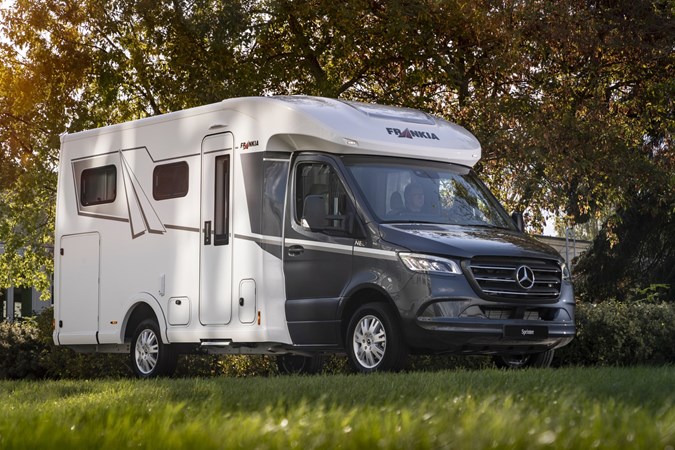
This is a semi-integrated or coachbuilt motorhome based on the Sprinter tractor head – which means it retains the Mercedes cab and interior. Increasing numbers of these vehicles are based on 3.5-tonne chassis to allow younger motorists to indulge, but this was on a hefty 4.5-tonne platform to give plenty of payload.
Carthago Chic C-Line
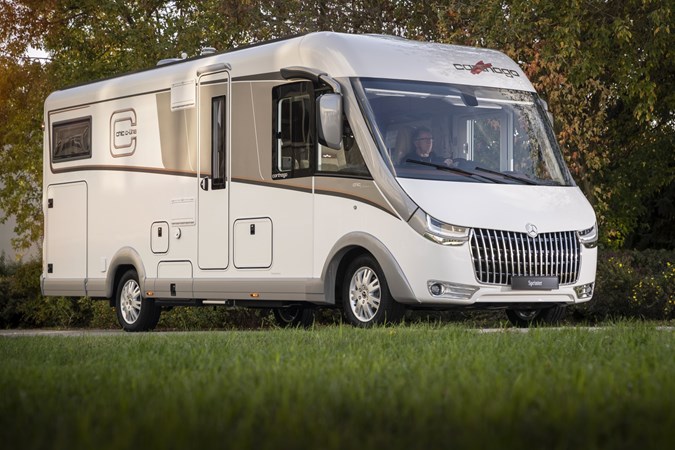
If it weren’t for the badge on the front you wouldn’t know this was a Sprinter. Fully integrated or A-Class motorhomes are especially popular in Germany, where they’re often supplied with just a single door and sold as ‘liners’. How nautical. But they’re popular in the UK too, where the top end of the market enjoys their bespoke nature. This, too, was built around the Tractor head.
Bimobil LBX 365
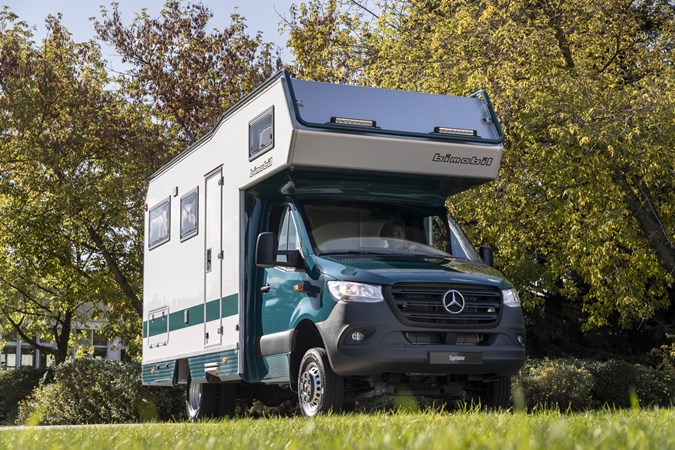
This is a vehicle designed not just for surviving the apocalypse but thriving in comfort after it. It’s based on the Sprinter 4x4 with a super-strong camper body on the back. Fresh and waste water tanks, plus an onboard generator means it’s fully set up for life off-grid.
People-moving
The Sprinter van offers really excellent ride comfort – a feature we’ve noted in our review – making it ideal for minibus conversions. Mercedes also notes that cab comfort is a major factor, as drivers may spend their whole working day behind the wheel.
Passenger comfort is important too – maybe not for all, but certainly for discerning business shuttle operators, who prefer a premium vehicle for that all-important first impression.
Route optimisation in the navigation software aids with multiple pickups and dropoffs, while the forthcoming fully electric eSprinter could become popular in cities with increasing restrictions on combustion-engined vehicles.
Sprinter ‘City 75’
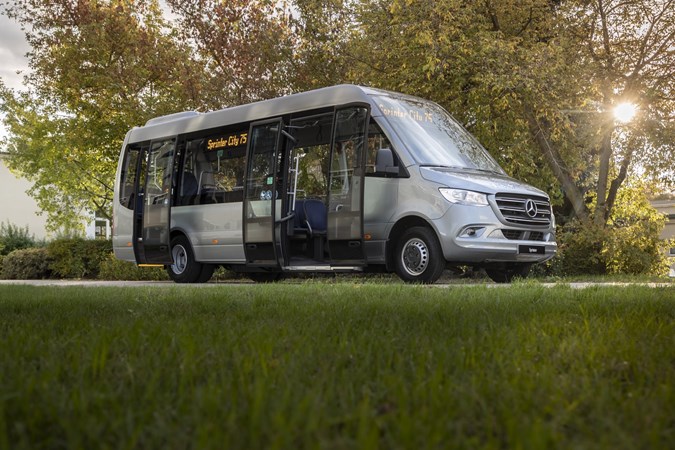
Where a full-sized bus platform is too big, a 38-seat minibus makes a lot of sense. This version has everything you’d expect from a ‘proper’ bus, including destination boards on the front, rear and sides, a low-floor area for wheelchair users and a heavy-duty 6.8-tonne chassis.
Sprinter ‘Tourist Wedding’

Because why would you ever want to move wedding guests around in a van that didn't have cream leather seats, standard-fit ribbons and ‘elegant shelving’?
Delivery
The aforementioned eSprinter – not to mention its smaller eVito sibling - could also be of real use to the parcel and delivery sector. Literally billions of parcels are delivered each year, and many undertake their last few miles in busy towns and cities, where a zero-emissions van would sidestep any forthcoming restrictions.
Route-optimisation nav software is useful in this instance too, while some of the conversions Mercedes showed us had useful features such as big kerbside sliding doors to make deliveries quicker and easier.
Grocery delivery is also a massive industry, especially in the UK. An experimental all-electric e-Vito refrigerated van named the Arctic Fox is a particularly interesting development, with a fully-integrated cold compartment that shares use of the traction batteries in a seamless electrical system.
eVito ‘Arctic Fox’
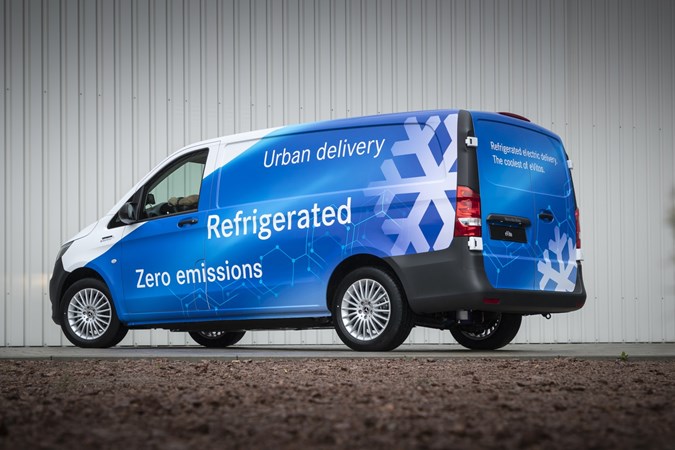
Still only a concept for now, but this refridgerated, all-electric Vito van has undergone a trial with the food box company HelloFresh in Belgium as proof of concept.
Epitomising the way in which bodybuilders can work with Mercedes on these vehicles, the Arctic Fox is more than just a refrigeration unit strapped into a van – rather, it’s entwined with the van’s own systems and capable of using the traction batteries as its own. This minimises the need for additional batteries and streamlines the whole process.
Craft and construction
In this sector, a few things matter. Payload is one – unfortunately Mercedes can’t really claim top gong here – but reliability is another, and the brand reckons customers are happy to pay the premium for a three-pointed star if it comes with extra dependability.
That’s especially true of construction vans, which often drive over unmade surfaces and are rarely treated gently when on site.
An app-based system allows operators to remotely lock and unlock their vehicles to have suppliers deliver tools or materials to restock the vehicles overnight, while for builders a range of tippers, dropsides and pickups plus big crew cabs mean decent configurability, depending on use.
JPM SAS three-way tipper

A lightweight aluminium bed helps with payload here – it’s important to keep the total vehicle weight under 3,500kg so that drivers with standard car licences can take their share of the time behind the wheel. In this case, doing so still achieves a hefty payload of 1,260kg.
Emergency services
Whether it’s straightforward patient transportation, first-response paramedic vehicles or police riot vans, the emergency services require a high degree of strength and flexibility.
These aren’t intended to be pursuit vehicles, so outright performance isn’t really an issue – most ambulances are limited in top speed, anyway, as travelling at great speed with such heavy bodywork (not to mention potentially fragile casualties on board) would be undesirable.
Again, it’s lightweight construction that counts here, as well as reliability and dependability. If a construction truck breaks down, it’s not the end of the world – if a paramedic’s vehicle does, it very well could be for the unlucky.
Tigis Europa by Ambulanz Mobile
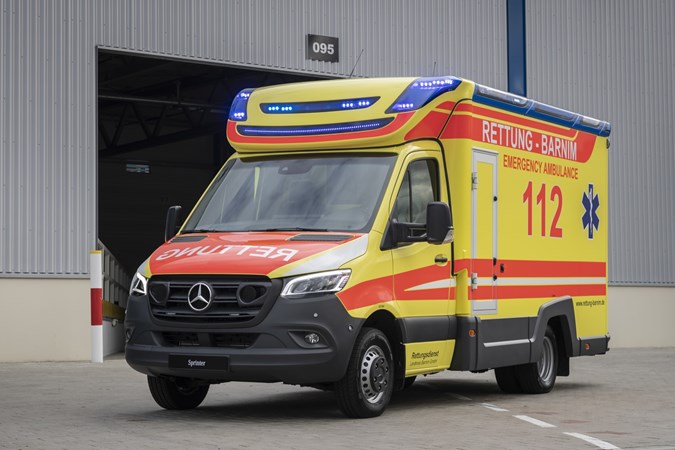
The ambulance unit itself sits on the chassis and can be easily swapped out in case of damage – vital to keeping these vehicles on the road with as few interruptions as possible. The body itself is made from smooth ABS plastic, with no sharp corners, making disinfection an easy process.
Restricted mobility
Again, it's ride comfort and dependability that matters most here - as well as comfort and technology features found on passenger cars, especially important if the converted vehicle is to be a wheelchair user's main, everyday transport.
Also read:
>> Van conversions at the VW Converter Expo
>> Highlights from the 2019 Dusseldorf Caravan Salon
>> Mercedes-Benz Sprinter full review
Just so you know, we may receive a commission or other compensation from the links on this website - read why you should trust us.

